-
Posts
2,263 -
Joined
-
Last visited
Content Type
Profiles
Forums
Store
Help Articles
Posts posted by Jim D.
-
-
3 minutes ago, Elle Bee said:
Oops, forgot to mention... in case anyone is wondering, this Brod and Taylor proofing box is the one I'm thinking of getting.
I have one of those. I don't mean to discourage you, but I find assembling it each time a very annoying task. And because it's nowhere near airtight, I wouldn't expect it to hold temp very accurately (which may not be an issue for you). I did, however, find a great use for the little tray that holds water to provide the moisture in the proof box: I lay it on top of parchment, and when I'm letting chocolate sit to form a shell, I put the mold on that tray. In that way the mold doesn't drip so much chocolate down onto the parchment, and I can maintain a hint of neatness.
-
 1
1
-
-
@Elle Bee An additional thought about trying to keep chocolate in temper while melting it: It's very difficult to do. Greweling mentions it as a way to melt chocolate from the bag and keep it in temper--but for ganache. So it is somewhat easy for the small amount required for ganache, but for large amounts, the chocolate will probably stay quite viscous and will need to be taken well beyond the temper stage, then brought back down. Silk makes all this so much easier.
And to add to your future equipment possibilities: I use a dehydrator to melt colored cocoa butter and large amounts of chocolate overnight and am very pleased with it. I can melt milk chocolate in the Mol d'Art while simultaneously melting dark in the dehydrator. No equipment I have found maintains an exact temperature, including the Mol d'Art and the dehydrator, but, as you know, chocolate life means adjusting to reality in ever-changing ways.
I also must comment on your dislike of running up and down stairs constantly: I do it with 14 stairs dozens of times a day. That's what makes it possible to snack from the chocolate bag from time to time. 😁
-
 3
3
-
-
3 hours ago, Elle Bee said:
2. Those of you who use Greweling's slab method with the cream cooled to 40C/105F, how fluid is your chocolate when you add the cream to it?
This depends so much on the chocolate you are using. Mine is usually flowing easily, though certainly thicker than the cream. If melted chocolate is noticeably viscous, I would say you have a problem, probably with humidity in the work space.
3 hours ago, Elle Bee said:3. In the event my chocolate ends up getting warm enough to go out of temper, should I just pour it into my Rev 2 temperer and retemper it before mixing it with the cream? Or can I just go ahead and mix it with the cream without retempering since I will also be adding silk to the ganache to make it set up faster? (I have several jars of silk ready at 33.5C in my sous vide container.)
First, although Greweling says that chocolate used for a slab must be tempered, not everyone does that. I have used it tempered and untempered and have not (to be honest) noticed any difference. If it is out of temper and you are adding silk later, then it will be tempered.
3 hours ago, Elle Bee said:4. How long can I hold it in the oven like this? I think some of you with proper melters can keep your chocolate in there for long periods... like days, maybe?
Sometimes I hold mine in my Mol d'Art melter for days, but I definitely don't trust it to be in temper after such a long time. It will almost certainly be overtempered. As you probably know, there are several methods of bringing overtempered chocolate back into temper; all involve melting some of the excess Type V crystals.
3 hours ago, Elle Bee said:5. Should the container be covered or uncovered? I think real melters have covers, but do I need to worry about condensation forming under the lid?
When I leave chocolate in the melter overnight, I cover it so that the heating process is more efficient. When I am making shells, I leave it uncovered (so that I can dump excess chocolate into it), but I take the cooler ambient air into account when setting the temperature. Unless you experience very humid conditions in your work space, I don't see condensation as a problem--if it is, you would need to take more drastic action to lower the humidity.
-
 2
2
-
-
47 minutes ago, Chocolate_touu said:
Grewlign’s butter ganache in his book ?
It's on page 204 of the second edition. You can substitute something else for the balsamic vinegar (such as a reduced strawberry purée or good-quality strawberry flavoring or compound). According to Greweling's notes on butter ganache, the mixture is very forgiving about the amount of liquid you add. Just one caution: you may find the taste (strawberry in this case) somewhat muted in a butter ganache--the price you pay, I guess one could say, for having a longer shelf life.
-
 2
2
-
-
8 hours ago, Chocolate_touu said:
Hello everyone, i want to make strawberry chocolate bonbons how to make a simple ganache i want it with 2 weeks shelf life , any recipe ?
What I do for my strawberry Easter eggs is to pipe in a relatively small layer of strawberry pâte de fruit, then on top of it a layer of Kerry's strawberry buttercream with added natural strawberry flavoring from Amoretti. The PdF adds a lot of flavor. My Aw measurement was 0.73, which is not bad.
-
 1
1
-
-
@Dark side, since you have called me out for my nagging, I feel I have no choice but to respond to your questions. As I say quite often, I consider myself still a learner in this business, by no means an expert. Mostly it's been trial and error, with a great deal of the latter. With that caveat...
Yes, on the .7mm Grex--though pastrygirl's Spanish airbrush sounds intriguing. Having to stop to heat up your spraying device becomes more annoying than you might at first imagine. Even if you go for a less expensive airbrush, I would definitely get one in the trigger style.
I have a California Air Tools compressor with 4.6 gal. capacity. If I were doing it over, I would get the same brand but with a larger capacity. I am finding that as time passes, the compressor is running more often, and experts say that is bad for the device in the long run. The price differential for a larger one is not great. More significantly: If you decide later to get a spray gun (a move that is quite common in the business), the 4.6 gal. compressor struggles (and runs almost constantly). Spray guns, by the way, are quite inexpensive, relatively speaking.
I know others disagree, but I found using a box, fan, and filter inadequate for keeping overspray out of the air, and the filter clogged up very quickly. With the CakeSafe booth, the "pre-filter" has to be changed quite often, but I don't find the cost of filters exorbitant, and I can see clearly when it needs to be replaced. I realize that the cost of the CakeSafe may be a factor, especially as you are just beginning.
I have said this next thing before, but I'll repeat it here: Clairvoyance would be very helpful when considering chocolate equipment, but obviously is in short supply. I wasted money buying equipment that in no time at all became inadequate (airbrush, compressor, etc.). If you grow to enjoy making decorated chocolates, you will be hooked, people will find their way to you, and you will want/need to make more, and then your first Christmas season will hit you over the head. With that in mind, I will add that even my moderate production quantities are made more bearable by having a Fuji spray gun. You can spray many more molds without having to reheat the gun because it holds much more cocoa butter than the Grex (or any airbrush I know of). The Fuji (and other spray guns) are also more forgiving in pushing cocoa butter through the nozzle. I have found that a few grains of unmelted cocoa butter can clog my Grex and require much use of a heat gun, whereas a spray gun can handle that issue much better (proof of this just last week: the Grex refused to spray, no amount of heat or stirring with my thermometer would unclog it, in disgust I poured the CB into my Fuji, and it sprayed the same CB without issue).
Will airbrushing take longer than hand painting? Perhaps a little longer, but the quality is so much better. I never had much success trying to cover a mold by using a paintbrush--the cocoa butter was streaked, it ran, coverage was spotty. In a few seconds you can cover an entire mold with spray from an airbrush. One of chocolatier Kalle Jungstedt's useful insights is that over-brushing a mold will take the cocoa butter out of temper and cause it to stick to the mold.
If I were in your position and had all the advice now available on eGullet on this topic, I would probably get the Grex again (I use the Fuji much more often these days--but the Grex is excellent in doing gradients and similar detailed work, which the Fuji is not always good at), but I would definitely get a compressor with capacity to service a spray gun.
-
 4
4
-
-
On 1/11/2024 at 9:48 PM, GRiker said:
Thanks @Jim D..
I understand that when you're making a two layer ganache you put the 3/8" on the bottom since you'll be spreading your untempered chocolate there. By using the larger ruler on the bottom, you ensure that your finished product has equal thicknesses of the two different flavors.
When you're making a 1/2" ganache, are you concerned that using an untempered foot at the base of your ganache leaves you with a ganache layer that is less that 1/2"?
I'm finding that stainless steel bars are pretty pricey, hoping to buy the right ones the first time!
Yes, my setup for two layers is as you describe, and it does result in more or less the same height for each layer.
For the 1/2", I don't worry about the height I'm losing (there's only so much I can worry about). If you are concerned, you could purchase an extra 1/8" bar (if you can find it). Aluminum bars might work as long as they are glued down (with chocolate) thoroughly.
-
1 hour ago, GRiker said:
Yes, I still use this method, and yes, I use untempered chocolate for the foot. There are several opinions on the foot: Some say tempered chocolate (I find it shatters easily), some say overtempered chocolate (I'm not even sure how to achieve the overtempered state without taking a lot of time), some say untempered (which sometimes shatters, but not often). I heat it to well over 100F so that it doesn't start hardening before I can spread it. And I definitely spread it on acetate and then spread the filling on top of it. I don't put the foot on top unless it's a very soft filling that is not going to be easy to dip later, then it gets "two feet," so to speak.
-
I used Felchlin's 72% Arriba for the bottoms, and it worked very well (I didn't use any heat). The ganache had sunk a bit more than I desired, so the Arriba layer was thick and therefore is less than perfect for biting. I suppose I should make sure my customer dental insurance is paid up. But the gratifying part is that the dark chocolate counteracts the sweet date filling quite well, and I have made a note to use dark for the shell in the future. Even though the Aw is very good, the ganache needs a bit more cocoa butter to firm it up. It has an amazing quantity of Amarula in it; I think the ganache proportions work because Amarula is the only liquid (no cream) and because the dates add a huge amount of solids. I am pleased with the date, lemon, and Amarula combination, and @Kerry Beal, I thank you for that idea.
-
 3
3
-
-
6 minutes ago, Kerry Beal said:
I have always suspected the the chocolate running behind the coloured cocoa butter is caused by the heating! I've not been happy with the results most times I've done it.
And yeah - dates and amarula - sweet! Maybe some lemon?
I've already included lemon. Perhaps some more is called for.
-
 1
1
-
-
15 minutes ago, Kerry Beal said:
No reason not to use two different chocolates. I'm not a big fan of the heating thing though.
I'm interested in your remark on "the heating thing." So many famous chocolatiers swear by it (Kalle Jungstedt, KIrsten Tibballs, just to name two) that I began to think I must be missing something. It does seem to help with that phenomenon of chocolate running behind the colored cocoa butter in certain molds.
The reason I came to the idea of using a dark bottom on this bonbon was the filling. I took your idea of pairing Amarula liqueur with dates. I developed a recipe, measured its Aw, tasted it countless times with various chocolates, etc. The conclusion was that the filling tasted best with caramelized white. But today, when I got to producing these bonbons (and had already made the shells, of course), they tasted much too sweet. It turns out dates are sweet--who knew? I'm now mulling over my options for rescuing the bonbons--nursing a little Amarula on the rocks seems to help the process.
-
I have some bonbons shelled in caramelized white chocolate and, to counteract some of the sweetness, would like to use a dark chocolate to seal them. Is there any inherent reason different chocolates can't be used for the main shell and the bottom? I don't ordinarily use a heat gun on bonbons before pouring the sealing layer (with the exception of caramel fillings, where the slight melting seems to help stop any leaking), but I thought that in this case I would use that step just to encourage the two parts to stick together.
-
38 minutes ago, Rajala said:
It's only heated a bit. But in the next test run, I'm going to roast the flour - thinking it will give off a better flavor.
I was going to say that if you are using raw flour, there is the issue of taste. I assume the filling is sticking together with butter or something similar? There might be the issue of having a filling that is too dry, taste-wise, and there is the consideration that ganaches dry out as they sit. But if this turns out as well as your cinnamon bun recipe (which I use frequently), then I will have to beg for the recipe.
-
1 hour ago, Rajala said:
I've been experimenting for some time with a "brownie" bonbon filling (the only trace of chocolate is in form of cocoa powder), that contains flour. Is there anyone with experience in terms of using flour in fillings and what to think about in terms of food safety? Is it considered safe as long as you keep an eye on everything as usual? I mean, there are baked goods that lasts for month, although with a lot of preservatives in them.
The AW of the filling is 0.6229 - so on its own, it's pretty low.
The brownie idea sounds interesting. I don't think there should be an issue with using flour. If there is one, there are certainly a lot of chocolatiers using some form of cookies in their bonbons who would be in trouble. In fact, there is one of them located just down the street from you (more or less), Kalle Jungstedt, who uses cookie layers a lot. Of his tiramisù's savoiardi layer, he writes: "the cookie base is water free with months of shelf life."
-
Following Kerry's diagnosis and suggestions: I would, in the future, definitely make the hazelnut paste alone, then mix it with chocolate, heat the mixture, then temper it (preferably over cocoa butter silk if you have it, by stirring over cold water, or by tabling the whole mass). The heat resulting from processing plus the initial heat of the hazelnuts is probably taking the chocolate way out of temper. Peter Greweling writes: "Because gianduja is a fat system, and not an emulsion, there is no danger of separation." It would appear you have proved Professor Greweling wrong! But his diagnosis and remedies for "overly viscous" gianduja may prove helpful:
The cause of this situation, he writes, is "excessive processing, resulting in heat damage" or "insufficient cocoa butter in chocolate." His remedy for the first issue is "Do not process gianduja in the machine excessively after the chocolate is added" and, for the second, "Use chocolate with sufficient cocoa butter content." If you take Kerry's suggestion and tackle a small quantity of your "split gianduja" at a time, you might have success. If you put a little melted cocoa butter or tasteless oil in the processor, then add the defective gianduja a little at a time through the feed tube, the two fats (chocolate and hazelnuts) might come together once again. Other than that, the only step I can think of is to make this into a kind of ganache, adding a little liquid, and see if an emulsion will form. The resulting mixture will be more perishable than gianduja. But if this issue occurs again, adding cocoa butter (whether by using a chocolate with higher cocoa butter content or by adding plain melted cocoa butter) sounds like the best idea. What brand of chocolate did you use?
-
 1
1
-
-
9 hours ago, Saltychoc said:
My last two collections. Each batch of the dots I did fewer and fewer per bonbon. Still think I did something like 20K+ dots. I learned my lesson! Green - pear pate and "eggnog" Ivoire and a little caramelia w/amazing fresh nutmeg. Redish - chocolate orange. Blue - lemon buttercream & dark choc. Gold - caramel & gingerbread milk choc, finally got my caramel filling almost perfect with this batch - not a single leak in the batch of straight caramels. And I was so happy with the spice blend I made for the gingerbread. A little Cambodian black peppercorn really made it.
Without the dots - red - apple cider pate and miso caramel ganache - turned out really well. I did end up getting Wood's cider jelly (Thanks Jim!) to mix with apple butter I made with local apples and the miso ganache is caramelized local miso infused into this great local grass fed cream and a blend of a few chocolates, honey as the sweetener. Black - hazelnut gianduja, chopped hazelnuts, blackberry ganache. Blue - double Earl Grey (interestingly this has been the MOST popular flavor with mid-aged kids). Orange - cinnamon buttercream & Basque chili dark choc.
Beautiful display and interesting flavors. And you do come up with unusual ingredients. Who knew a variety of black peppercorns comes from Cambodia? I am struck by your success with Earl Grey and kids. I don't make it often because most people don't seem to like it. I experimented last time with adding some bergamot flavoring, and it was more successful. Did you use the same mold for both boxes? The ones in the top box appear to be "flattened domes," but that could just be the angle.
-
 1
1
-
-
30 minutes ago, Becky R said:
All you artists are amazing. Thanks for sharing your creations. Very inspirational! What I want to know is, does your kitchen look like mine? (Complete disaster area!! My hubby can't WAIT for this chocolate season to be over!). LOL
If you husband is upset now, tell him to wait until you start doing this fulltime. A clean kitchen will be the exception rather than the rule. That is, unless he wants to build you a chocolate kitchen.
-
 1
1
-
-
19 minutes ago, LMHmedchem said:
I didn't add any water, is that really necessary? Would that help with the issue of the butter separating?
I don't think that I melted the caramel enough to use a blender. Do you know what temperature you melted it to? Is there any concern in introducing too much air by using a blender?
LMHmedchem
This separation has happened to me as I was first making the caramel, but you would have to melt it enough (regardless of the temp) to use an immersion blender (I am not referring to a stand blender). If you keep the blade below the level of the caramel, bubbles can be kept at a minimum. Obviously if your caramel is on the firm side, you would need a strong blender.
-
45 minutes ago, LMHmedchem said:
The separating butter could be an issue but I am not sure what to do about that other than to give it a good stir. The butter issue would get worse if you heated it to a higher temperature so I would keep it under 170F.
I have had butter separate from caramel. If you think of caramel as an emulsion (fat in the butter with water in the caramel), then it makes sense. I use an immersion blender to force the butter back into emulsion since sometimes stirring is not enough.
-
 2
2
-
-
16 hours ago, Pete Fred said:
Hmmmm, I think in a proper kitchen I'd probably get a saucepan chucked at my head for too much fussin' and wasting time. However...
I still prefer doing it the old-fashioned way, i.e. rolling out a circle and lifting it into the ring, rather than cutting out strips and discs. I'm quite methodical about gradually easing the pastry down into the corners so that it doesn't stretch or introduce folds. Once there's a nice right-angle, I'll kinda work my way around, pulling the pastry away from the ring and pressing it back from the bottom to the top, trying not to trap any air pockets. The excess pastry is then trimmed away with a knife. Some days are better than others, but that's my routine for getting it as smooth as possible.
After a rest in the fridge, the tart shell gets blind baked. Press together two or three large sheets of clingfilm (plastic wrap) and line the pastry right into the corners. Fill with rice up to the height of the ring; this is important because, as the pastry cooks it will stay tight against the ring and even grow upwards a little. I like to cook it long with the rice (~40 mins in a 170C/340F oven) until quite set. Carefully use the clingfilm to lift out the rice then return to the oven (150C/300F) for the base to take on some colour (still inside the ring). Remove from the oven and leave to cool fully. The rim of the tart shell will be overcooked, but if you place it on a flat surface (your baking sheet might be a bit wonky) you can trim it away with a microplane until it's perfectly level against the top of the ring.
I adjust the blind bake as needed. The custard tart, for example, gets fully blind baked until deep brown and biscuity because the filling is cooked at 90C/190F so the pastry won't take on any more colour. But I held back with the pear tart because the pears were added then cooked at 180C/350F for another 25 minutes and I didn't want the pastry to over-brown (apart from the rim which got microplaned at the end).
I've just read all that back and it sounds faintly ridiculous. Saucepans are no doubt bouncing off laptop screens at this very moment, quite rightly.
I hope it wasn't too opaque, and there was something in there you found useful. 👍
You won't get any complaints about over-complexity from me (I make chocolates--complexity is a given and obsessive attention to detail is a requirement). One issue: Cling wrap (at least in the U.S.) is not considered oven-safe. Some experts say a low temp is OK, but that wouldn't work for pie crust. Rose Levy Beranbaum says to use parchment, maintaining that foil doesn't let air through and creates a cardboard crust. I've never been sure I agree with her, but I do use parchment with dried beans. Unfortunately parchment doesn't fit tightly against a crust. Another problem I have is that fussing with the crust too much (to get it into the cracks and crevices) causes it to soften (I make a mostly butter crust with just a little shortening to make it pliable--Julia Child recipe).
In any event, I will use your directions to work on my crust, and I thank you for them very much. Your creations are impressive.
-
 1
1
-
-
When chocolate is overheated in the microwave, you will know it. It usually has a terrible smell and little bits of burned chocolate in it. And, as a side note, this can happen more easily than you might think. I use very short intervals of microwaving at the beginning of the process.
I have had melted chocolate that looks like your photo. Often it just goes away during the process of tempering. In a few extreme cases, I used an immersion blender on it, and the chocolate smoothed out quickly. Just be sure to keep the blender blade immersed in the chocolate to avoid air bubbles.
-
 3
3
-
-
4 hours ago, Kerry Beal said:
I put together a recipe for Rodney for a competition a couple of years ago sponsored by Amarula - it wasn't for a chocolate filling - it was a tart riffing off Cape Breton 'Pork Pies'. What I learned from that - dates and amarula go well together.
Excellent idea. I have a filling based on dates and will try it with Amarula. I might try it with figs as well.
-
 1
1
-
-
Some of my assortment for Christmas 2023. There are 24 different fillings, with an emphasis on those that attempt to imitate the taste and texture of various desserts (baklava, tiramisù, apple crisp, pecan pie, bananas Foster, cinnamon bun). My favorite new ingredient to play with was Amarula cream liqueur. It is similar to Bailey's Irish Cream but has other nuances of flavor. I immediately thought of pairing it with coffee, but that turned out to be more difficult than I anticipated. Amarula has a taste that seems assertive but was easily overpowered by chocolate and coffee. It is, on the other hand, great for sipping.
-
 11
11
-
 2
2
-
-
On 12/15/2023 at 1:12 PM, Pete Fred said:
Dorie Greenspan's Pear Tart with Crunchy Almond Topping...
I didn't like the look of her pastry so used my own with some ground hazelnuts. I also cooked the pears in more butter, and used Armagnac... because France.
It was nice. Next time I'll increase the amount of pears so it fills the tart more generously.
The tart looks delicious. I am quite impressed with the perfection of your crust. How do you get that ultra-smooth exterior? and keep it from slumping down in the tart pan as it bakes? If you have posted about this previously, please just point me to the post.



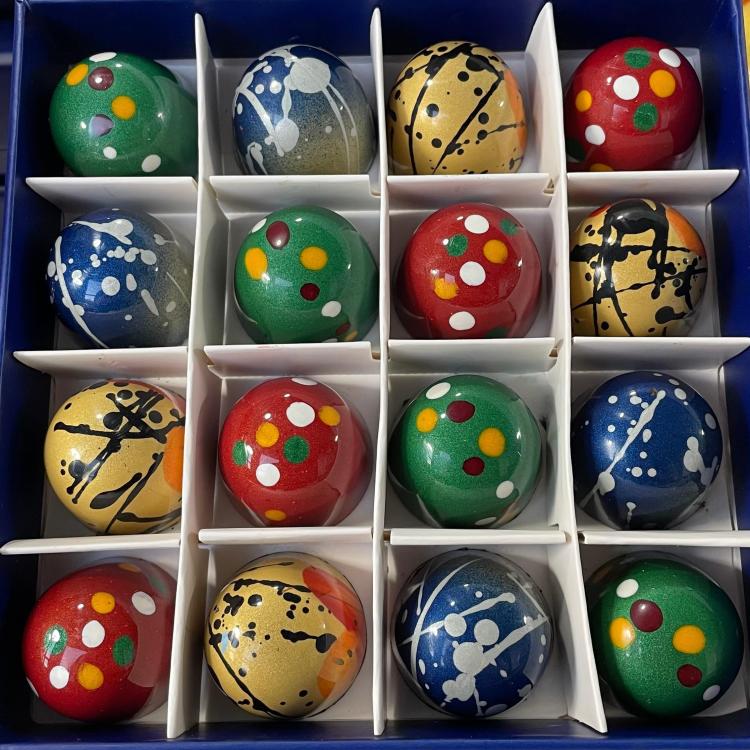
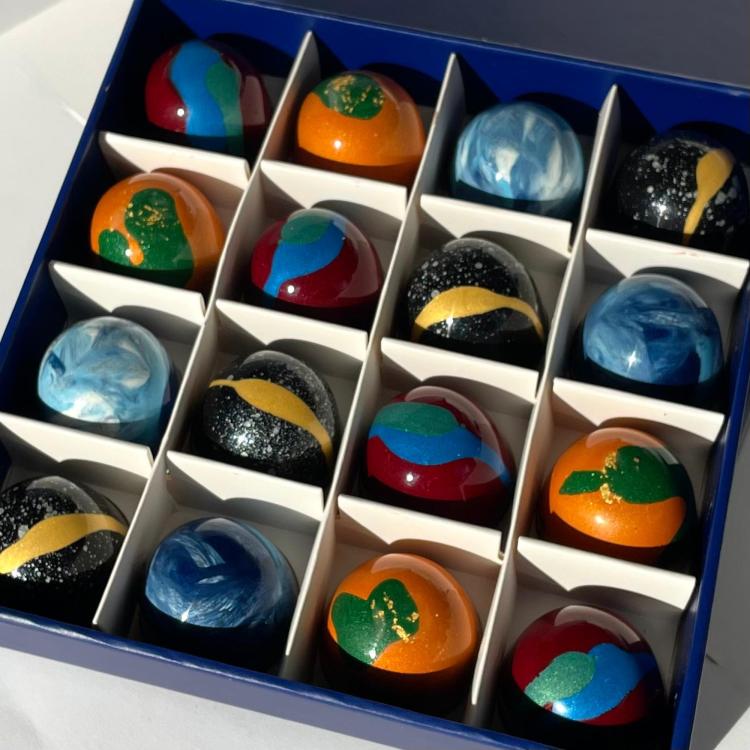
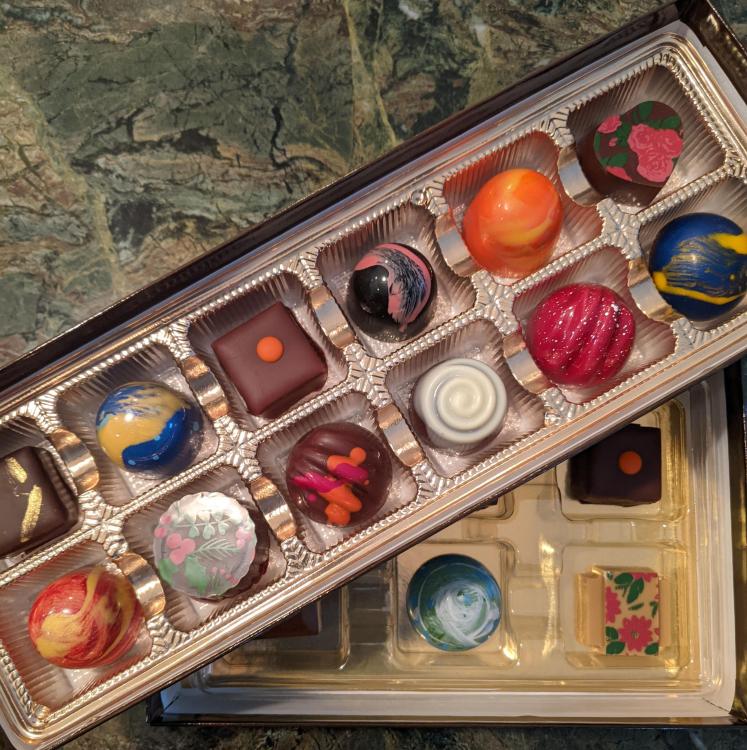
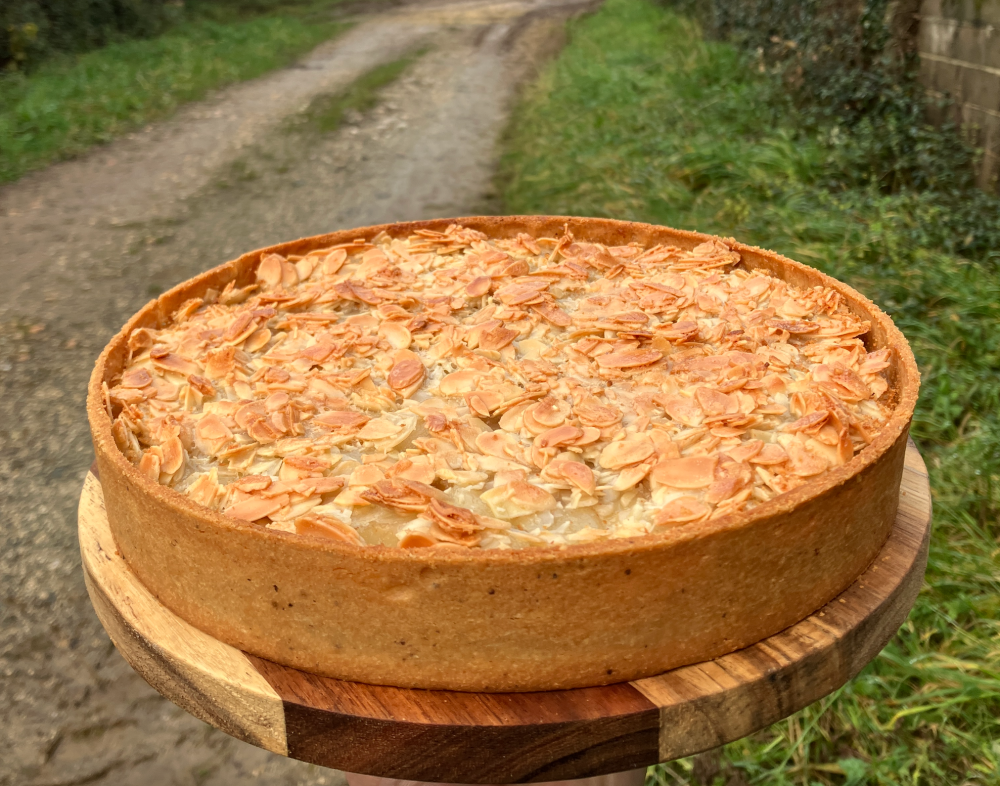
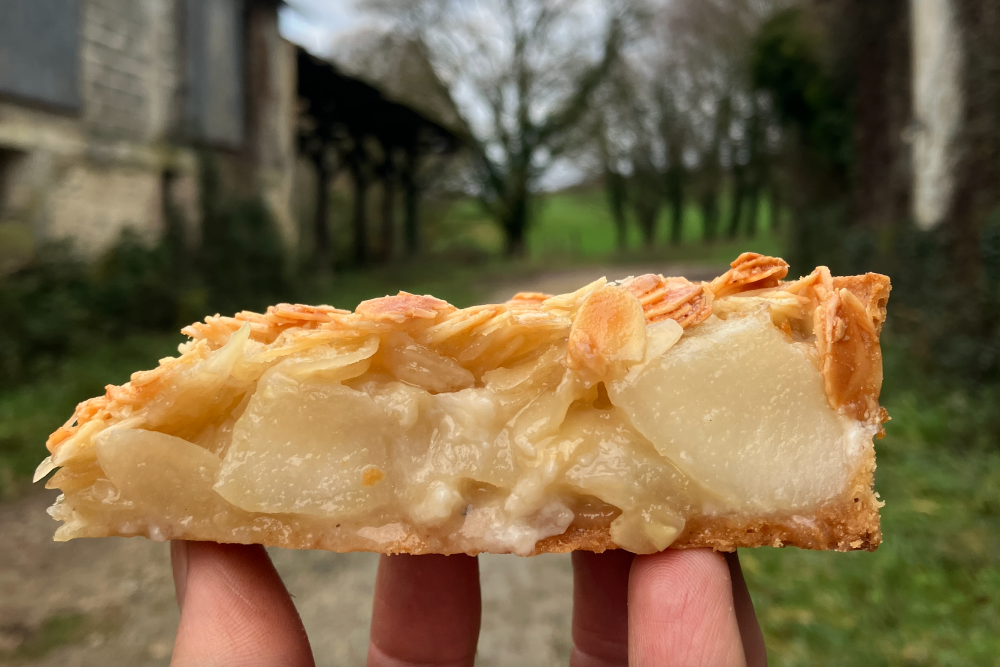
Cleaning chocolate molds after airbrushing
in Pastry & Baking
Posted
As displayed in the accompanying photo I am still having trouble with bits of colored cocoa butter staying in molds. The pattern is the same, suggesting there may be a single cause This is driving me crazy as the saga goes on and on, and I am looking at every possibility to eliminate the cause. My latest inquiry brings me to the use of silk.
I have tried using the warming tray method (described earlier in this thread), but with the heat barely on. It's better, but I have a terrible time getting the excess CCB off the molds and I continue to get the little bits of CCB staying in the cavities. I mostly use my Fuji sprayer, and there is no question it sprays out a lot of CCB. I have tried moving the gun farther away, but that didn't seem to make a difference in the coverage. All these explorations have brought me to the tempering possibility, namely, is the CCB overtempered and is therefore crystallizing immediately? I watch experts decorating shells, and they casually turn a mold upside down and easily wipe away all the excess CCB. I cannot do that. So I am brought to a new question: is it possible to add too much silk when tempering CCB? I don't weigh it, I just put some in (following the example of the esteemed inventor of the EZtemper).